OCZ Vertex 4 Review (128GB), Firmware 1.4/1.5 Tested
by Kristian Vättö on August 4, 2012 10:00 AM ESTAnandTech Storage Bench 2011
Last year we introduced our AnandTech Storage Bench, a suite of benchmarks that took traces of real OS/application usage and played them back in a repeatable manner. Anand assembled the traces out of frustration with the majority of what we have today in terms of SSD benchmarks.
Although the AnandTech Storage Bench tests did a good job of characterizing SSD performance, they weren't stressful enough. All of the tests performed less than 10GB of reads/writes and typically involved only 4GB of writes specifically. That's not even enough exceed the spare area on most SSDs. Most canned SSD benchmarks don't even come close to writing a single gigabyte of data, but that doesn't mean that simply writing 4GB is acceptable.
Originally we kept the benchmarks short enough that they wouldn't be a burden to run (~30 minutes) but long enough that they were representative of what a power user might do with their system. Later, however, we created what we refer to as the Mother of All SSD Benchmarks (MOASB). Rather than only writing 4GB of data to the drive, this benchmark writes 106.32GB. This represents the load you'd put on a drive after nearly two weeks of constant usage. And it takes a long time to run.
1) The MOASB, officially called AnandTech Storage Bench 2011—Heavy Workload, mainly focuses on the times when your I/O activity is the highest. There is a lot of downloading and application installing that happens during the course of this test. Our thinking was that it's during application installs, file copies, downloading, and multitasking with all of this that you can really notice performance differences between drives.
2) We tried to cover as many bases as possible with the software incorporated into this test. There's a lot of photo editing in Photoshop, HTML editing in Dreamweaver, web browsing, game playing/level loading (Starcraft II and WoW are both a part of the test), as well as general use stuff (application installing, virus scanning). We included a large amount of email downloading, document creation, and editing as well. To top it all off we even use Visual Studio 2008 to build Chromium during the test.
The test has 2,168,893 read operations and 1,783,447 write operations. The IO breakdown is as follows:
| AnandTech Storage Bench 2011—Heavy Workload IO Breakdown | ||||
| IO Size | % of Total | |||
| 4KB | 28% | |||
| 16KB | 10% | |||
| 32KB | 10% | |||
| 64KB | 4% | |||
Only 42% of all operations are sequential; the rest ranges from pseudo to fully random (with most falling in the pseudo-random category). Average queue depth is 4.625 IOs, with 59% of operations taking place in an IO queue of 1.
Many of you have asked for a better way to really characterize performance. Simply looking at IOPS doesn't really say much. As a result we're going to be presenting Storage Bench 2011 data in a slightly different way. We'll have performance represented as Average MB/s, with higher numbers being better. At the same time we'll be reporting how long the SSD was busy while running this test. These disk busy graphs will show you exactly how much time was shaved off by using a faster drive vs. a slower one during the course of this test. Finally, we will also break out performance into reads, writes, and combined. The reason we do this is to help balance out the fact that this test is unusually write intensive, which can often hide the benefits of a drive with good read performance.
There's also a new light workload for 2011. This is a far more reasonable, typical every day use case benchmark. It has lots of web browsing, photo editing (but with a greater focus on photo consumption), video playback, as well as some application installs and gaming. This test isn't nearly as write intensive as the MOASB but it's still multiple times more write intensive than what we were running last year.
We don't believe that these two benchmarks alone are enough to characterize the performance of a drive, but hopefully along with the rest of our tests they will help provide a better idea. The testbed for Storage Bench 2011 has changed as well. We're now using a Sandy Bridge platform with full 6Gbps support for these tests.
AnandTech Storage Bench 2011—Heavy Workload
We'll start out by looking at average data rate throughout our new heavy workload test:
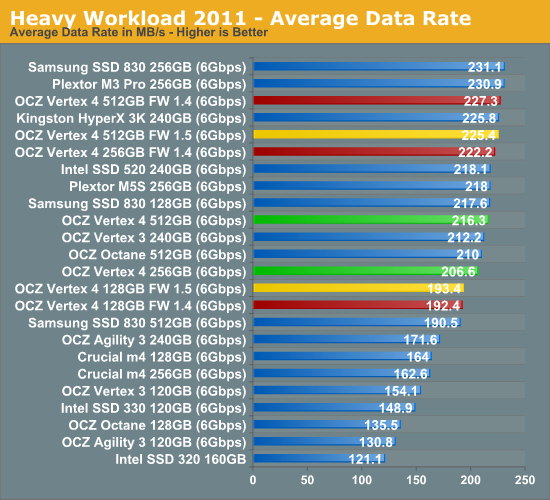
The 1.4 update brought a small boost in our Heavy suite. As you can see in the table above, most IOs are small and the 1.4 and 1.5 firmwares brought marginal improvements to small transfer size performance.
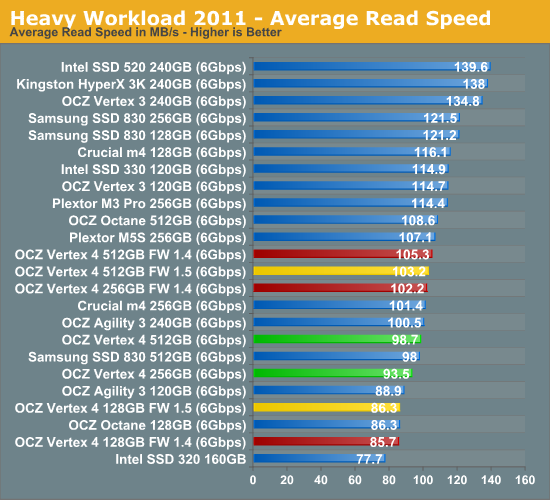
As I mentioned in the previous page, Vertex 4 still lacks read performance at small transfer sizes and the above graphs supports this. The average write performance is very good however and definitely makes up for the middle of the road read performance.
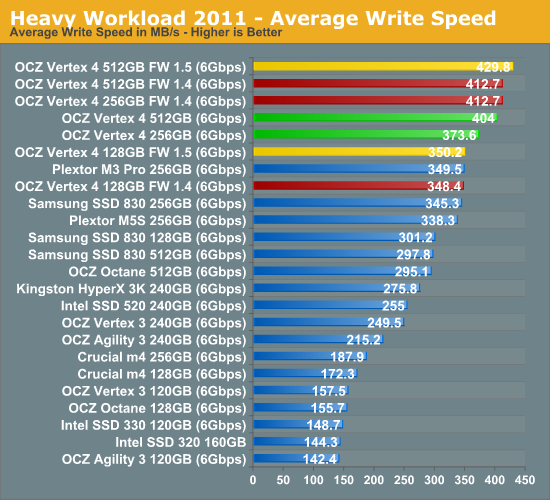
The next three charts just represent the same data, but in a different manner. Instead of looking at average data rate, we're looking at how long the disk was busy for during this entire test. Note that disk busy time excludes any and all idles; this is just how long the SSD was busy doing something:
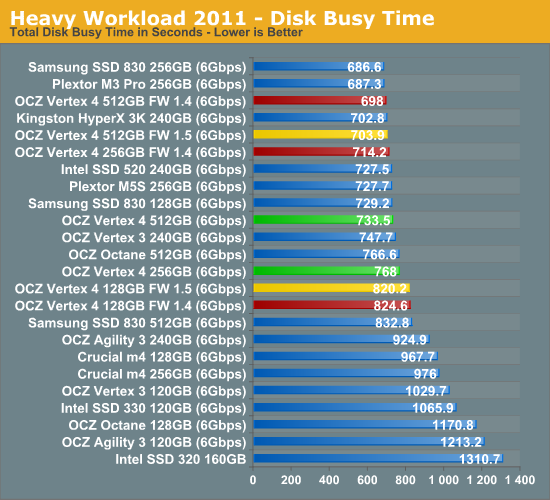
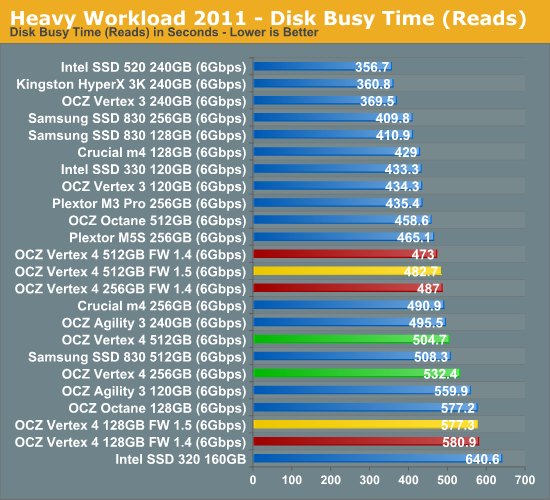
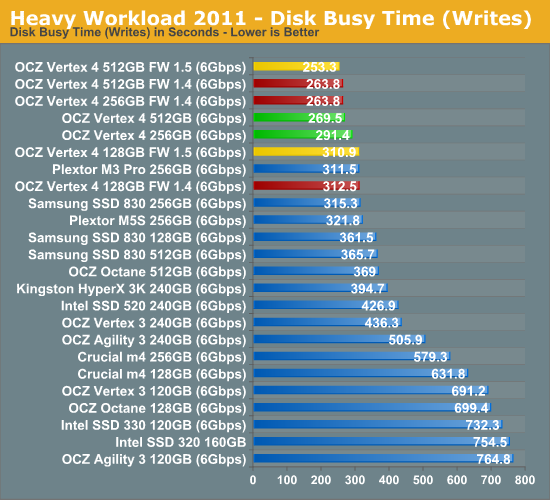










60 Comments
View All Comments
menting - Sunday, August 5, 2012 - link
aside from the first generation SSD that never got public release, Crucial uses the marvell controller with in-house firmware.They are looking to make their own controller in the future AFAIK, but I dont know when that is supposed to happen.
0ldman79 - Tuesday, August 7, 2012 - link
I'll have to back up the customer review of Crucial. I had a problem with Crucial once about 14 years ago. After a 5 minute phone call it took about a week and I had a replacement stick in my hand.Sound like Crucial's quality control went to pot for a little while there. Two bad products in 15 years... wow.
JNo - Sunday, August 5, 2012 - link
Quite. In the UK the Samsung 830 is cheaper than the Vertex 4 (at 256GB for example).The 830 is cheaper, faster, made by a company that also manufactures all the components and firmware *and* has a much more reliable track record both for the drive and especially for SSDs in general where OCZ has been plagued by poor quality (I don't care if it was because of unreliable sandforce controllers - they decided to buy them and sell them).
It's a no brainer imo - DON'T buy the Vertex 4! Why would you?! This article spent did a lot of good analysis when it could have just been a one-pager saying that the Vertex 4 has new firmware which makes it slightly faster in certain conditions but it's still slower and more expensive than competition which has a more reliable track record.
Coup27 - Sunday, August 5, 2012 - link
I like Crucial, but you really need to get your facts straight before spouting off like that. As has been mentioned below, the m4 controller is made by Marvell and is in use in more SSD's than the m4.The m4 has also had 5 firmware updates, one of which was to correct a catastrophic failure after 6 months of use.
Samsung is the ONLY SSD vendor who makes all the parts.
pc_void - Tuesday, August 14, 2012 - link
" It's a very dirty under handed tactic to get good benchmark scales by leaving it under 50% than the customer not knowingly gets screwed."Yet Toms writes: "OCZ certainly ups the Vertex 4's game with its new software, and we commend the fact that the company is striving to improve its products."
The OPPOSITE of what you say. Hmmm.
brichter - Wednesday, September 5, 2012 - link
You're correct, I didn't find the 512GB for $385 final, it was $379, $359 after $20 rebate. No shipping as I bought it in-store and no tax as I'm a resident of Oregon.The OCZ has 256 bit AES hw encryption, whereas the Crucial doesn't support hw encryption at all.
I own both a Crucial and (now) an OCZ, they are comparable in performance judged by my butt -dyno, with 2 MBP 8,2s side by side. Both these drives are faster in my Macs than in my Windows machines, there wasn't more than a couple seconds difference in boot times on my Win7 desktop between the SSDs and the RAID1 (2x 500GB Seagate spinning platter drives), so the bang per buck is much better with the cheap 500GB Seagates in a Windows box.
The following comment comes from the Tom's review, dated a couple of weeks before your post:
But our story doesn't simply end with vindicated testing results. OCZ quickly pushed out a firmware version 1.5 to alleviate some of what we observed the last time around. The latest build significantly helps the drive to remain in “performance mode” and significantly reduces the shortcomings identified in OCZ Vertex 4 128 GB: Testing Write Performance With Firmware 1.4.
MrSpadge - Sunday, August 5, 2012 - link
No. "Performance Mode" is a bonus feature, which you may or may not get, depending on your usage of the drive. Sure, benchmarks should take this into account. However, the practical differences between any modern high-performance SSDs are small anyway.mattlach - Sunday, August 5, 2012 - link
I am also concerned about this.How much does the performance differ between performance mode and normal mode?
I bought this drive based on previous reviews which did not mention this feature.
I am concerned that once I add more data to the drive, I'll get something significantly worse than I paid for.
Omoronovo - Sunday, August 5, 2012 - link
As the article states, you will get the same performance you would have had you bought the drive when it released (or with 1.3 firmware).You bought the drive based on previous reviews which were on older firmware which didn't have this feature.
When at less than 50% drive capacity you get almost double write performance and better overall performance in many situations. When you go past 50%, you still get improved write performance (improvements in the firmware that extend beyond performance mode), but you just lose the extra sequential write speeds which you wouldn't have had in the first place without the update.
You aren't going to get anything worse than EXACTLY what you paid for; just that in many situations you'll now get something BETTER.
mattlach - Monday, August 6, 2012 - link
I didn't base my purchase off of 1.3 firmware reviews.I saw those and thought "my the read performance of this thing is surprisingly poor", and then continued my research of other drives.
Then other sites 1.4 and 1.5 reviews started coming out, showing the read speed issue having been resolved (but not mentioning the performance mode) which is when I bought the drive.
As always Anand's reviews are better than other sites on SSD's and now I am aware of this issue, and almost feel cheated somehow...
So are you saying this mostly impacts write performance? If that is the case I am less concerned. I write once and read many, so I don't care as much about the write performance as I do about the read performance.